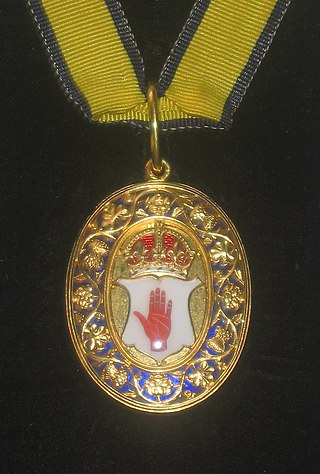
A baronet or the female equivalent, a baronetess, is the holder of a baronetcy, a hereditary title awarded by the British Crown. The title of baronet is mentioned as early as the 14th century; however, in its current usage it was created by James I of England in 1611 as a means of raising funds for the crown.

Baron Hazlerigg, of Noseley in the County of Leicester, is a title in the Peerage of the United Kingdom. It was created in 1945 for Sir Arthur Hazlerigg, 13th Baronet. He had previously served as Lord Lieutenant of Leicestershire. As of 2023 the title is held by his great-grandson, the fourth Baron, who succeeded his father in 2022.
There have been three baronetcies created for members of the Anstruther family, two in the Baronetage of Nova Scotia and one in the Baronetage of Great Britain. Two of the creations are extant while one is extinct.
The Stronge baronetcy of Tynan was conferred in the Baronetage of the United Kingdom on 22 June 1803. The family were northern Irish landowners of Tynan Abbey, County Armagh, also possessing the residence of Lizard Manor, Aghadowey, County Londonderry.

There have been two baronetcies created for persons with the surname Maclean, one in the Baronetage of Nova Scotia and one in the Baronetage of the United Kingdom. Both creations are extant as of 2010.
There have been two baronetcies created for persons with the surname Ross, both in the Baronetage of the United Kingdom. One creation is extinct while one is still extant.
There have been three baronetcies created for persons with the surname O'Neill, two in the Baronetage of Ireland and one in the Baronetage of the United Kingdom.
There have been two baronetcies created for members of the Haggerston, later Constable Maxwell-Scott family, one in the Baronetage of England and one in the Baronetage of the United Kingdom. Only one creation is extant as of 2008. The Haggerston, later Constable Maxwell-Scott Baronetcy, of Haggerston in the County of Northumberland, was created in the Baronetage of England on 15 August 1642 for Thomas Haggerston, of Haggerton Castle, Northumberland, a loyal Royalist who served as a colonel in the army of King Charles I. The Haggerston were recusant in the 17th century and the estates were sequestered and forfeit to the Commonwealth of England in 1649 but were repurchased by the first Baronet in 1653. The line of the fourth Baronet failed on the death of the twelfth Baronet in 1972. The title reverted to the line of William Haggerston, second son of the third Baronet and younger brother of the fourth Baronet. In 1746 he inherited estates in Yorkshire from his great-uncle Sir Marmaduke Francis Constable, 4th and last Baronet, of Everingham, and assumed the surname of Constable in lieu of his patronymic. In 1758 he married Winifred, daughter of Robert Maxwell, titular sixth Earl of Nithsdale, and assumed by Royal licence the additional surname of Maxwell. Winifred was considered to be the heiress to the Scottish lordship of Herries of Terregles held by her father. Constable-Maxwell built a new house at Everingham Park on the Constable estate in Yorkshire.
There have been seven baronetcies created for persons with the surname Sinclair, six in the Baronetage of Nova Scotia and one in the Baronetage of Great Britain. Four of the creations are extant as of 2008.
The Sinclair Baronetcy of Stevenson in the County of Haddington, is a title in the Baronetage of Nova Scotia. It was created on 18 June 1636 for John Sinclair of Stevenson, with remainder to his heirs male whatsoever. The third Baronet was a Baron of the Exchequer and member of the Privy Council of Scotland. The fourth Baronet married Martha, daughter and eventual heiress of Sir John Lockhart of Castlehill, a Lord of Session under the judicial title of Lord Castlehill. The eighth Baronet was an Admiral in the Royal Navy. On the death in 1899 of his son, the ninth Baronet, the title passed to a descendant of James Sinclair, younger son of the fifth Baronet, who in 1764 had inherited the Lockhart estates and assumed the surname of Lockhart. The tenth Baronet was a major general in the British Army and assumed the additional surname of Lockhart. The eleventh Baronet was the son of George Duncan Lockhart, another descendant of James, younger son of the fifth Baronet.
John Gordon, 3rd Earl of Aboyne was the son of Charles Gordon, 2nd Earl of Aboyne and Elizabeth Lyon. He succeeded his father as 3rd Earl of Aboyne in April 1702. On the date of his death 7 April 1732, he was succeeded in his titles by his eldest son. He was just 32 years old.

The Lockhart, later Lockhart-Ross Baronetcy, of Carstairs in the County of Lanark, was a title in the Baronetage of Nova Scotia.
The Denham of Westshield Baronetcy was created on 31 January 1693 in the Baronetage of Nova Scotia for William Denham.
Three Steuart baronetcies were given to three brothers, the first, fourth, and seventh of the seven sons of Sir James Steuart, knight, Lord Provost of Edinburgh, who died in 1681.

Thomas Reynolds-Moreton, 1st Earl of Ducie was the first Earl of Ducie.
Sir Robert Charles Sinclair, 9th Baronet DL (1820–1899) was a baronet in the Baronetage of Nova Scotia, the ninth of the Sinclair-Lockhart baronets of Murkle in the County of Caithness and of Stevenson in the County of Haddington.
James Douglas, 2nd Earl of Queensberry was a Scottish noble, politician and Covenanter.
Alexander Macdonald Lockhart; July 1806 - 27 October 1861) was a British Conservative politician and landowner.
The Lockhart baronetcy, of Lee in the County of Lanark, was created in the Baronetage of the United Kingdom on 24 May 1806 for Alexander Lockhart, Member of Parliament for Berwick-upon-Tweed. He was a member of the extended Lockharts of Lee family. The title became extinct on the death of the fifth baronet in 1919.